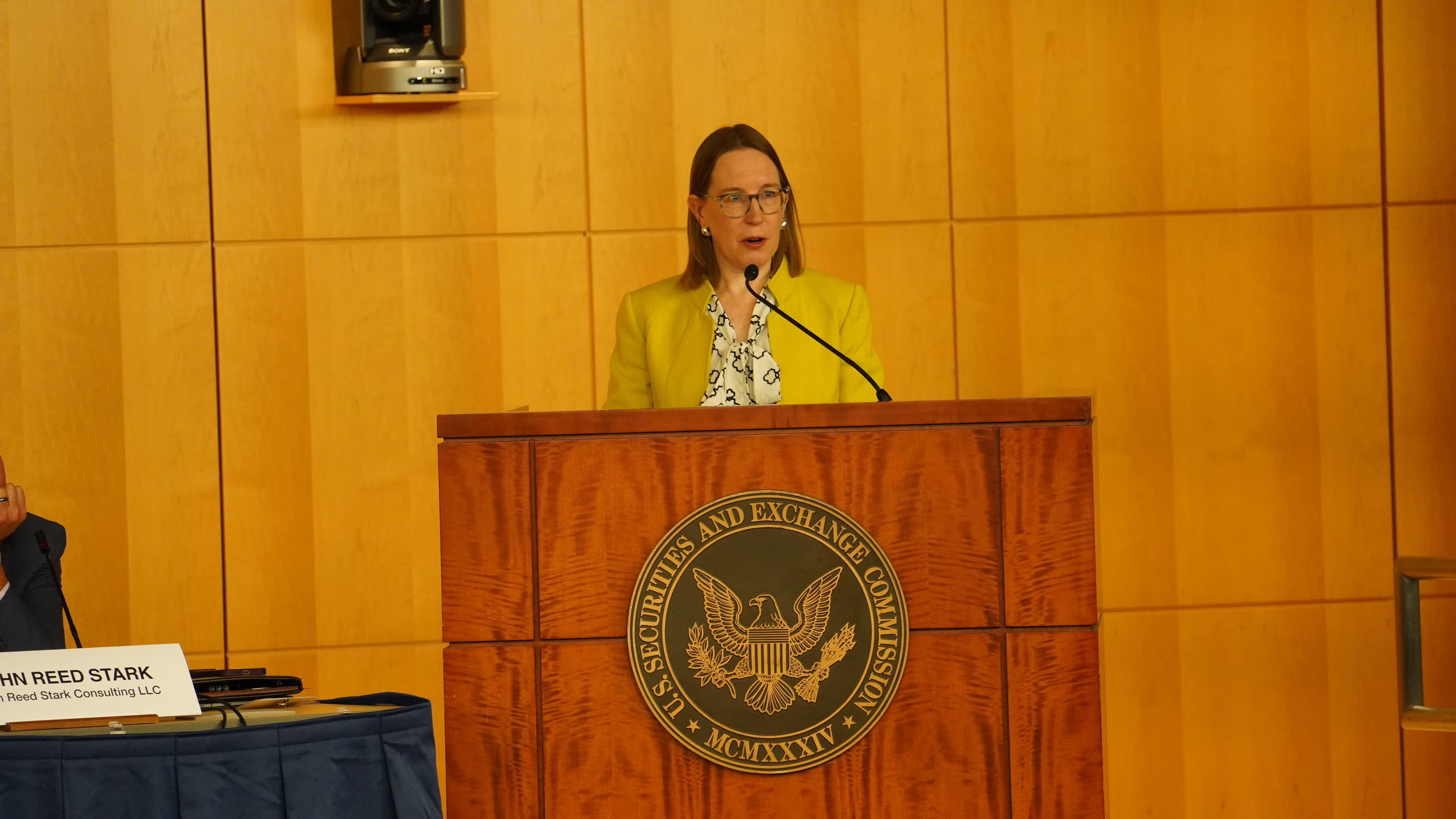Uncategorized
SEC ‘Earnest’ About Finding Workable Crypto Policy, Commissioners Say at Roundtable

WASHINGTON, D.C. — The staff at the U.S. Securities and Exchange Commission has embraced the chance to finally work with the crypto industry to hash out policy for overseeing digital assets transactions, said Commissioner Hester Peirce, the head of the agency’s crypto task force.
The securities regulator is ready «to seek earnestly to find a workable framework,» Peirce said at the agency’s first crypto-focused roundtable on Friday. «I think we’re ready for the spring ahead,» she said, referring to the title of the day’s event, the «Spring Sprint Toward Crypto Clarity.»
The task, according to Peirce: «Can we translate the characteristics of a security into a simple taxonomy that will cover the many different types of crypto assets that exist today and may exist in the future?»

Mark Uyeda, the agency’s acting chairman, told reporters that despite recent SEC policy statements that certain areas of the crypto sector aren’t subject to securities laws — memecoins and mining, so far — it’s a «definitely possibility» that others will be defined as securities.
«We’re moving on multiple tracks here,» he said in answer to a question from CoinDesk. Each statement issued so far «ultimately is a staff statement» that doesn’t have legal backing, but he said the roundtable represents the entire commission — currently three members — looking at what a «potential commission interpretation might look like.»
In his opening remarks at the event, Uyeda, who was appointed by President Donald Trump as the SEC awaits a Senate confirmation of Paul Atkins, argued that the agency should have been more willing in recent years to make such interpretations public.
«When judicial opinions have created uncertainty from our participants in the past, the commission and its staff have stepped in to provide guidance,» Uyeda said. «This approach of using common rulemaking for explaining the commission’s process or releases rather than enforcement actions, should have been considered for classifying crypto assets under the federal security laws.»
Panel discussion
The panel discussion saw a dozen securities attorneys in the crypto sector weigh in on the specific issues they saw as they advised companies.
«What’s the biggest question that you face in trying to wrestle with this question?,» moderator Troy Paredes, a former SEC commissioner who now runs consulting firm Paredes Strategies, asked Sarah Brennan, the general counsel at Delphi Ventures and one of the 11 panelists.

«The specter of the application of securities laws has moved early-stage projects in the market to sort of take an arc very similar to [initial public offerings], where they stay private longer,» she replied.
«These assets in the traditional model are designed to have wide, broad early distribution and most of the market is hedging that on the application of securities laws, so it ends up looking a lot like your traditional markets where people will marshal their way to an exchange listing without that broad dissemination or price support or actually fully launching the technology.»
The panel featured critics of the industry alongside attorneys who have worked to develop the sector.
«Whether you’re talking yield farms or ostrich farms or orange groves, the whole point of securities regulation was to wrap that all up into a very big, broad, principles-based regulation,» former SEC attorney John Reed Stark said. His concern is that, even in 2025, much of the market lacks utility.
«If it all went away tomorrow and you weren’t speculating in it, you wouldn’t care,» he said.
Legislator questions
Ahead of the roundtable, Sen. Elizabeth Warren and Rep. Jake Auchincloss, both Massachusetts Democrats, wrote an open letter to Uyeda asking about the SEC’s staff statement on memecoins and how it was developed.
The letter asked whether anyone at the SEC communicated with the White House about the statement, whether the White House’s crypto working group had directed the SEC to do anything and why the staff statement was not built into formal rulemaking.
Warren and Auchincloss also asked the SEC to explain how it would specifically define memecoins as distinct from «general cryptocurrency,» how it would distinguish between actual memecoins and memecoins that don’t meet the staff statement, and which memecoins the SEC analyzed in drafting its staff statement.
Business
Crypto Trading Firm Keyrock Buys Luxembourg’s Turing Capital in Asset Management Push

Crypto trading firm Keyrock said it’s expanding into asset and wealth management by acquiring Turing Capital, a Luxembourg-registered alternative investment fund manager.
The deal, announced on Tuesday, marks the launch of Keyrock’s Asset and Wealth Management division, a new business unit dedicated to institutional clients and private investors.
Keyrock, founded in Brussels, Belgium and best known for its work in market making, options and OTC trading, said it will fold Turing Capital’s investment strategies and Luxembourg fund management structure into its wider platform. The division will be led by Turing Capital co-founder Jorge Schnura, who joins Keyrock’s executive committee as president of the unit.
The company said the expansion will allow it to provide services across the full lifecycle of digital assets, from liquidity provision to long-term investment strategies. «In the near future, all assets will live onchain,» Schnura said, noting that the merger positions the group to capture opportunities as traditional financial products migrate to blockchain rails.
Keyrock has also applied for regulatory approval under the EU’s crypto framework MiCA through a filing with Liechtenstein’s financial regulator. If approved, the firm plans to offer portfolio management and advisory services, aiming to compete directly with traditional asset managers as well as crypto-native players.
«Today’s launch sets the stage for our longer-term ambition: bringing asset management on-chain in a way that truly meets institutional standards,» Keyrock CSO Juan David Mendieta said in a statement.
Read more: Stablecoin Payments Projected to Top $1T Annually by 2030, Market Maker Keyrock Says
Business
Crypto Trading Firm Keyrock Buys Luxembourg’s Turing Capital in Asset Management Push

Crypto trading firm Keyrock said it’s expanding into asset and wealth management by acquiring Turing Capital, a Luxembourg-registered alternative investment fund manager.
The deal, announced on Tuesday, marks the launch of Keyrock’s Asset and Wealth Management division, a new business unit dedicated to institutional clients and private investors.
Keyrock, founded in Brussels, Belgium and best known for its work in market making, options and OTC trading, said it will fold Turing Capital’s investment strategies and Luxembourg fund management structure into its wider platform. The division will be led by Turing Capital co-founder Jorge Schnura, who joins Keyrock’s executive committee as president of the unit.
The company said the expansion will allow it to provide services across the full lifecycle of digital assets, from liquidity provision to long-term investment strategies. «In the near future, all assets will live onchain,» Schnura said, noting that the merger positions the group to capture opportunities as traditional financial products migrate to blockchain rails.
Keyrock has also applied for regulatory approval under the EU’s crypto framework MiCA through a filing with Liechtenstein’s financial regulator. If approved, the firm plans to offer portfolio management and advisory services, aiming to compete directly with traditional asset managers as well as crypto-native players.
«Today’s launch sets the stage for our longer-term ambition: bringing asset management on-chain in a way that truly meets institutional standards,» Keyrock CSO Juan David Mendieta said in a statement.
Read more: Stablecoin Payments Projected to Top $1T Annually by 2030, Market Maker Keyrock Says
Business
Gemini Shares Slide 6%, Extending Post-IPO Slump to 24%

Gemini Space Station (GEMI), the crypto exchange founded by Cameron and Tyler Winklevoss, has seen its shares tumble by more than 20% since listing on the Nasdaq last Friday.
The stock is down around 6% on Tuesday, trading at $30.42, and has dropped nearly 24% over the past week. The sharp decline follows an initial surge after the company raised $425 million in its IPO, pricing shares at $28 and valuing the firm at $3.3 billion before trading began.
On its first day, GEMI spiked to $45.89 before closing at $32 — a 14% premium to its offer price. But since hitting that high, shares have plunged more than 34%, erasing most of the early enthusiasm from public market investors.
The broader crypto equity market has remained more stable. Coinbase (COIN), the largest U.S. crypto exchange, is flat over the past week. Robinhood (HOOD), which derives part of its revenue from crypto, is down 3%. Token issuer Circle (CRCL), on the other hand, is up 13% over the same period.
Part of the pressure on Gemini’s stock may stem from its financials. The company posted a $283 million net loss in the first half of 2025, following a $159 million loss in all of 2024. Despite raising fresh capital, the numbers suggest the business is still far from turning a profit.
Compass Point analyst Ed Engel noted that GEMI is currently trading at 26 times its annualized first-half revenue. That multiple — often used to gauge whether a stock is expensive — means investors are paying 26 dollars for every dollar the company is expected to generate in sales this year. For a loss-making company in a volatile sector, that’s a steep price, and could be fueling investor skepticism.
-

 Business11 месяцев ago
Business11 месяцев ago3 Ways to make your business presentation more relatable
-

 Fashion11 месяцев ago
Fashion11 месяцев agoAccording to Dior Couture, this taboo fashion accessory is back
-

 Entertainment11 месяцев ago
Entertainment11 месяцев ago10 Artists who retired from music and made a comeback
-

 Entertainment11 месяцев ago
Entertainment11 месяцев ago\’Better Call Saul\’ has been renewed for a fourth season
-

 Entertainment11 месяцев ago
Entertainment11 месяцев agoNew Season 8 Walking Dead trailer flashes forward in time
-

 Business11 месяцев ago
Business11 месяцев ago15 Habits that could be hurting your business relationships
-

 Entertainment11 месяцев ago
Entertainment11 месяцев agoMeet Superman\’s grandfather in new trailer for Krypton
-

 Entertainment11 месяцев ago
Entertainment11 месяцев agoDisney\’s live-action Aladdin finally finds its stars




